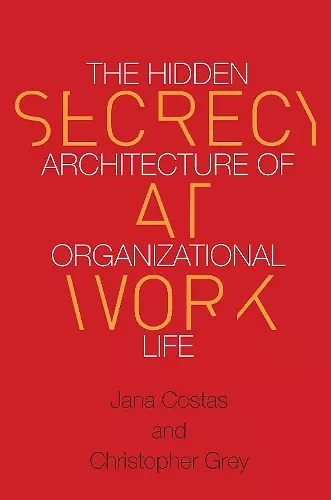Secrecy at Work
The Hidden Architecture of Organizational Life
Christopher Grey author Jana Costas author
Format:Hardback
Publisher:Stanford University Press
Published:30th Mar '16
Currently unavailable, and unfortunately no date known when it will be back
This hardback is available in another edition too:
- Paperback£27.99(9780804798143)

Secrecy is endemic within organizations, woven into the fabric of our lives at work. Yet, until now, we've had an all-too-limited understanding of this powerful organizational force. Secrecy is a part of work, and keeping secrets is a form of work. But also, secrecy creates a social order—a hidden architecture within our organizations. Drawing on previously overlooked texts, as well as well-known classics, Jana Costas and Christopher Grey identify three forms of secrecy: formal secrecy, as we see in the case of trade and state secrets based on law and regulation; informal secrecy based on networks and trust; and public or open secrecy, where what is known goes undiscussed. Animated with evocative examples from scholarship, current events, and works of fiction, this framework presents a bold reimagining of organizational life.
"In this engaging read, Costas and Grey lift the veil on the topic of secrecy to reveal the vital role that it plays in our organizing efforts. In an era where calls for transparency and openness dominate the organizational landscape, this book provides an alternative discourse to help readers understand and appreciate secret processes at work."—Craig R. Scott, Professor of Organizational Communication, Rutgers University and author of Anonymous Agencies, Backstreet Businesses, and Covert Collectives
"In their brilliant analysis, Costas and Grey break open a seam of organizing that we really haven't noticed till now. Of course organizations are structured around secrets, who is in the know and who isn't. Often fascinating, sometimes scary, this book reveals the ubiquity and potency of secrecy."—Amanda Sinclair, Amanda Sinclair, Professorial Fellow, Melbourne Business School
"Secrecy exists everywhere. It is essential to everyday interactions and to the functioning of organizations. Costas and Grey's book draws on classical theories, contemporary research, and a wide range of telling present-day examples. They have written a pioneering, highly readable study; full of insights about how secrecy works, their book will help to focus future research on this wonderful topic."—Steven Lukes, New York University
"This book sheds brilliant light on an area of organizational life that has not just languished in the dark, but has been systematically excluded from organizational theory. In doing so, it compels us to reconsider what we mean by 'organization' and how we study it. Essential reading for all organizational scholars, regardless of their theoretical, political or ideological positions."—Yiannis Gabriel, University of Bath
"We think of secrets as nouns, gems hidden by organizations. This compelling book challenges that idea, revealing secrecy as a verb—a ubiquitous mode of communication that constitutes organizational life. More than something that organizations have or do, Costas and Grey expose secrecy as a process that makes organizations what they are."—Karen Lee Ashcraft, University of Colorado Boulder
"This book provides a very engaging travelogue through the dynamic complexities of secrecy in organizations, brimming with insight and liberally spiced with always-interesting illustrations. If secrecy does indeed become more of a mainstream organizational topic, as Costas and Grey fervently hope, we will have them to thank for blowing the whistle."—Blake E. Ashforth , Administrative Science Quarterly
"There are nice echoes of post-war US interactionist sociology in the tone of this book, particularly in its refusal to engage in any particular grand or contemporary theorising...The idea of transparency in organizing, laudable in many ways, belies the fact that the control of information, and hence the production of secrecy, is constitutive of formal organization. Of course secrecy can exist outside formal organizations, as in the example of the lying lawyer who is also a lying father and husband, but formal organizations cannot exist without secrecy. The completely transparent organization would not be visible as an organization. In an age of conspiracies, when most people assume that organizations always lie, this book adds a great deal of nuance to that piece of cultural common sense."—Martin Parker, Cultural Sociology
ISBN: 9780804789011
Dimensions: unknown
Weight: unknown
216 pages